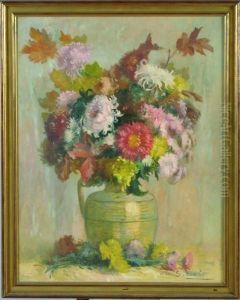Gaston Loir Paintings
Gaston Loir, a French painter born in 1867, was a versatile artist whose work spanned several genres, including genre painting, landscapes, and urban scenes. His oeuvre reflects the vibrancy and dynamism of late 19th and early 20th-century European life. Loir was part of the post-impressionist movement, a phase that sought to move beyond the impressionists' fascination with the natural effects of light and color to incorporate more structure and form into their works.
Loir's early life was steeped in an artistic environment, which significantly influenced his career path. His brother, Luigi Loir, was also a renowned painter, known primarily for his urban landscapes and scenes of Parisian life. This familial connection to the art world provided Gaston with valuable insights and exposure to artistic circles from a young age. He trained at the École des Beaux-Arts in Paris, which was the premier art institution in France, fostering his development as an artist and honing his skills in various mediums.
Throughout his career, Gaston Loir exhibited his work at several prestigious venues, including the Salon des Artistes Français in Paris, where he gained recognition and accolades for his contributions to French art. His paintings often depicted the bustling life of Paris, capturing the essence of the city's streets, cafes, and citizens with a vivid realism that also hinted at the underlying structures and forms shaping the urban environment. This dual focus on the immediate sensory experience of the city, as well as the architectural and social frameworks that defined it, marked Loir's work as both a continuation and an evolution of the Impressionist endeavor.
Despite his considerable talent and contributions to the art world, Gaston Loir's name is not as widely recognized today as some of his contemporaries. This relative obscurity may be attributed to the overshadowing fame of his brother, Luigi, and other more prominent figures of the post-impressionist movement. Nevertheless, his paintings continue to be appreciated by art historians and collectors for their technical proficiency, vibrant portrayal of early modern life, and the unique perspective they offer on the transition from Impressionism to the more structured approaches of post-Impressionism and modern art.
Gaston Loir passed away in 1922, leaving behind a rich legacy of artwork that captures a transformative period in European art and society. His contributions to the post-impressionist movement and the broader landscape of French art remain significant, offering insights into the complexities and nuances of this pivotal era.

